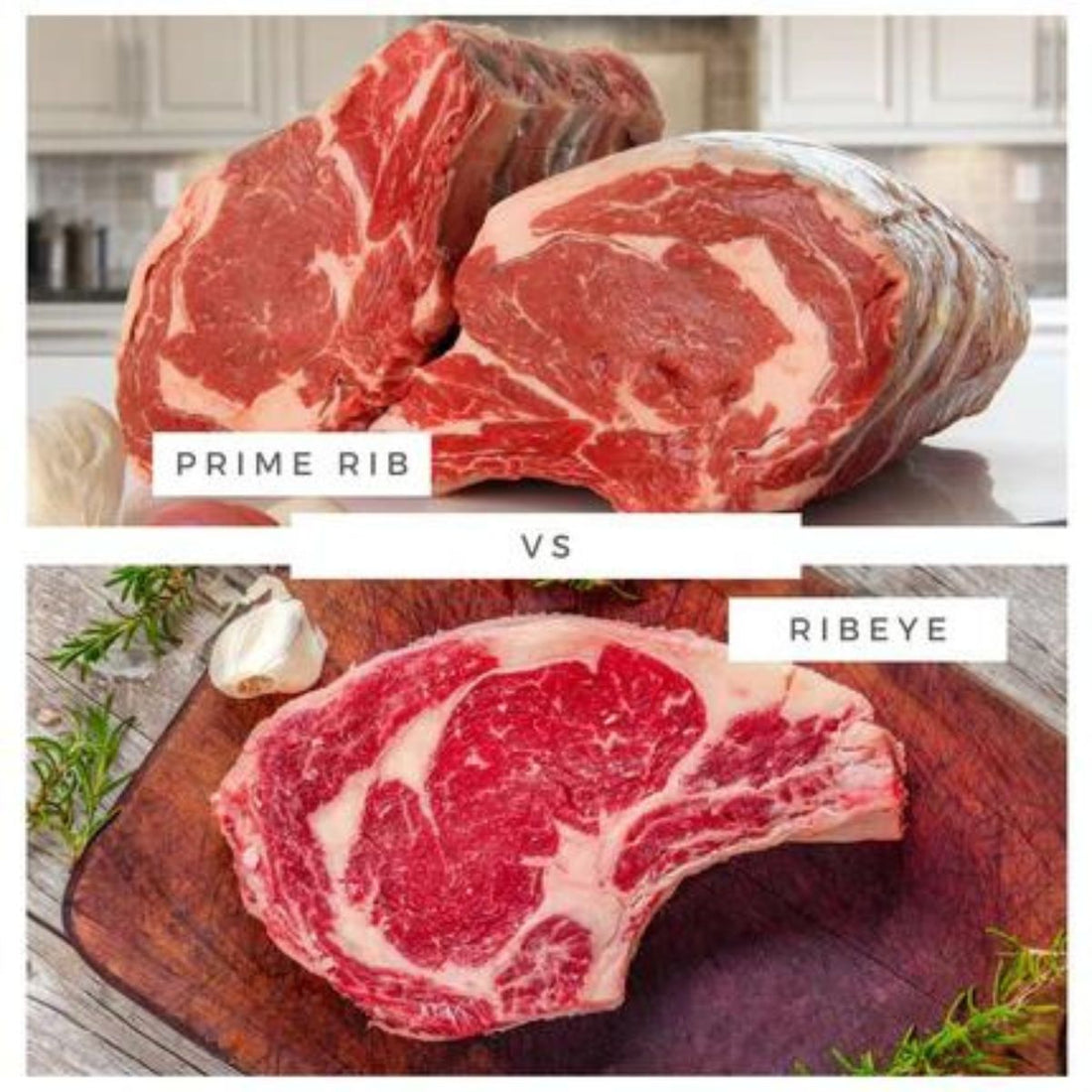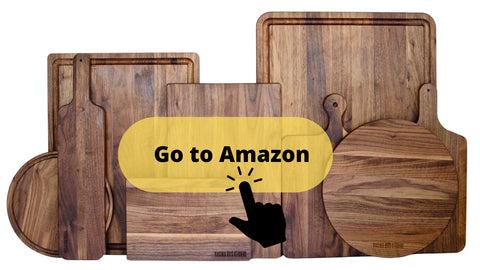Welcome, steak lovers! Get ready for a detailed look at one of the most delicious debates in American kitchens: Prime Rib versus Ribeye.
Whether it's the slow-roasted prime rib or the perfectly grilled ribeye, this guide will help you understand the key differences and decide which one suits your preferences.
Unveiling the Cuts: Prime Rib vs Ribeye
Prime rib and ribeye both come from the rib section of a cow but offer distinct textures and flavors. The prime rib is typically a larger roast, often served with the bone in, while ribeye steaks are usually boneless and known for their marbling. For additional information on steak cuts and where they come from in the cow, see our comprehensive guide on steak cuts.
Texture and Flavor
Prime rib is known for its tender, juicy texture, thanks to the fat cap that adds rich flavors during roasting. In contrast, ribeye offers a firmer bite with a distinct char from grilling, and while it has less marbling than prime rib, it remains flavorful.
Bone Presence: Influence on Cooking
The bone in prime rib enhances the cooking process, acting as a natural flavor infuser and moisture retainer. Ribeye steaks are often boneless, which makes them easier to handle on the grill.

Size Matters: Portioning for the Perfect Meal
Prime rib is ideal for large gatherings due to its grand size, while ribeye steaks are perfect for individual servings, offering a more manageable portion without compromising on taste.
|
Cut |
Texture |
Flavors |
Bone Influence |
Typical Portion Size |
|
Prime Rib |
Soft and succulent |
Rich with a pronounced fat cap |
Enhances flavor during roasting |
Large roast, ideal for groups |
|
Ribeye |
Semi-tender with firmness |
Full-bodied with less marbling |
Often enjoyed boneless |
Individual steaks, perfect for single servings |
Cooking Prime Rib: A Slow Roasted Delight
To cook a perfect prime rib, patience is key. Start by preheating your oven to 250°F. Boost your prime rib's flavor with a delicious seasoning blend (see our guide on Prime Rib Seasoning Blends For Everyday Use for some flavorful options).
Roast it slowly, allowing about 3 hours for a medium-sized roast. Use a meat thermometer to ensure it reaches the desired doneness.

Doneness Guide
|
Doneness |
Internal Temperature |
Rest Time |
|
Rare |
120°F |
15 min |
|
Medium Rare |
130°F |
20 min |
|
Medium |
140°F |
20 min |
|
Well Done |
160°F |
10 min |
Cooking Ribeye: Grilled to Perfection
For a ribeye steak, preheat your grill to a high temperature (450-500°F). Sear each side of the steak for 2-3 minutes to achieve a medium-rare finish. Let the steak rest after grilling to allow the juices to redistribute.
Marbling Magic: Decoding Fat Content
Marbling, the fat running through the meat, is essential for flavor and tenderness. Prime rib has more marbling, giving it a richer taste. Ribeye, while having less marbling, still offers a succulent bite.

The Prime Rib Experience: Traditionally Served
Prime rib is often paired with classic accompaniments like horseradish sauce, au jus, Yorkshire pudding, and roasted vegetables. These sides enhance the rich flavors of the meat and make for a well-rounded meal.
Choosing Your Cut: USDA Grading System Explained
Understanding USDA grades can help you choose the best meat. Prime grade has the most marbling, Choice has moderate marbling, and Select has the least. Prime is often reserved for fine dining, while Choice and Select are more common in everyday cooking.
Sidekicks of Steak: Best Pairings for Your Cut
Prime Rib Pairings
- Horseradish Sauce
- Yorkshire Pudding
- Roasted Brussels Sprouts
- Glazed Carrots
- Au Jus Gravy
Ribeye Complements
- Garlic Mashed Potatoes
- Sautéed Mushrooms
- Grilled Asparagus Spears
- Arugula Salad with Lemon Vinaigrette
- Crispy Shoestring Onions
- Green Beans and Beets

The Ultimate Decision: Which Cut is Right for You?
Consider your health priorities, budget, and cooking style when choosing between prime rib and ribeye. Ribeye is leaner and more economical, making it suitable for everyday meals. Prime rib, with its richer flavor and larger size, is perfect for special occasions.
Frequently Asked Questions
- What's the main texture and flavor difference between prime rib and ribeye?
- Prime rib is tender and juicy with rich flavors from its fat cap. Ribeye has a firmer bite with a distinct char and less marbling but is still very flavorful.
- Does the bone in prime rib affect its cooking method?
- Yes, the bone in prime rib enhances the cooking process, acting as a natural flavor infuser and moisture retainer. When I order this at the butchery, I would ask them to remove the bones but then tie it back on (yes, they do this!). The bones being tied back in helps with the cooking process to retain moisture.
- How do portion sizes vary between prime rib and ribeye?
- Prime rib is larger and ideal for group servings, while ribeye steaks are perfect for individual portions.
- What is the best cooking method for a slow-roasted prime rib?
- Oven roasting at a low temperature (250°F) is ideal, allowing the fat to melt and infuse the meat with rich flavors.
- How do I achieve the perfect charred crust on a ribeye steak?
- Preheat your grill to a high temperature (450-500°F) and sear each side of the steak for 2-3 minutes. Let the steak rest after grilling.
- What is marbling, and why is it important in choosing a steak?
- Marbling refers to the fat running through the meat, essential for flavor and tenderness. Prime rib has more marbling than ribeye, giving it a richer taste.
- Are there specific accompaniments that enhance the flavor of prime rib?
- Yes, classic sides like horseradish sauce, au jus, Yorkshire pudding, and roasted vegetables enhance the rich flavors of prime rib.
- What does the USDA grading system indicate about my steak?
- The USDA grading system categorizes beef into Prime, Choice, and Select grades based on marbling and maturity, helping you choose the best meat for your needs.
- How does ribeye pair with side dishes?
- Ribeye pairs well with garlic mashed potatoes, sautéed mushrooms, grilled asparagus, arugula salad, and crispy shoestring onions.
- How should health considerations affect my choice between prime rib and ribeye?
- Ribeye is leaner and has fewer calories, making it a better choice for health-conscious individuals. Prime rib is richer and has more fat.
- What's the cost difference between prime rib and ribeye?
- Prime rib is typically more expensive due to its larger size and bone-in status. Ribeye is more economical and suitable for everyday meals.
- How do my lifestyle and cooking preferences influence my choice between prime rib and ribeye?
- Choose ribeye if you prefer quick and easy grilling. Opt for prime rib if you enjoy slow-roasting and preparing meals for special occasions.
See Virginia Boys Kitchens On Amazon
We are on Amazon, see our storefront here. Use coupon code VBKBLOG10 for 10% off your entire purchase of any Virginia Boys Kitchens on Amazon. Apply the code at checkout.


